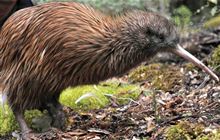New plant status report shows increased threats
Archived content: This media release was accurate on the date of publication.
Introduction
New Zealand’s plants are facing increasing threats according to a new scientific report published by DOC today.Date: 05 June 2018
The New Zealand Threat Classification System report updates the conservation status of 2785 known species or types of native vascular plants, which include flowering plants, conifers, ferns and club mosses.
About 80% of our native plants are endemic and found only in New Zealand but an increasing number are in trouble, says DOC acting Director, Terrestrial Ecosystems, Matt Barnett.
Overall, 14% of our vascular plants are nationally threatened, up from 11% in 2012.
There are now 113 more plants classified as ‘Threatened’ compared to the last assessment in 2012, which means there are now 402 plants in this category. Those in the ‘At Risk’ categories have increased by 101 (to 851 plants). Some of these changes are due to new understanding rather than documented decline.
“Threats like kauri dieback, browse by possums, goats, rabbits and other animals, and changes in land use, particularly in the eastern South Island, have caused the observed decline of 61 plant species, which are now in a worse state than five years ago,” says Matt Barnett.
“For the first time, kauri has been classed as threatened due to the unabated spread of kauri dieback.”
“There has also been a marked deterioration of populations of rare plants, such as sedge, cress and broom species, in the drylands of the Mackenzie and Waitaki basins due to land being modified for agriculture, as well as the impact of rabbits and hares.”
“The effect of the plant disease myrtle rust on New Zealand’s 30 or so myrtle species such as pōhutukawa, mānuka, rātā and ramarama, is still unknown but all of these species have been classed as threatened as a precautionary measure.”
The sheer number of vascular plants and lack of knowledge about their genetic makeup, distribution and ecology also poses challenges to their conservation. More than 200 plants – most as-yet unnamed – have been assessed for the first time in this report.
New information has also led to 39 plants gaining an improved status, while another two species have improved due to increased abundance.
One plant – the ground-hugging herb, pygmy goosefoot – was rediscovered in large numbers in several places in the eastern South Island in 2015 after an apparent absence of more than 50 years. As a result, this plant is no longer classed as extinct.
DOC works to protect native plants on conservation land from the effects of browsing animals through pest control and has programmes to safeguard specific populations of threatened plants around the country. The Department also works with iwi and other landowners to protect threatened plants on private land.
Often populations of threatened plants occur on private land and their conservation relies on the goodwill and involvement of land owners and managers as well as appropriate protective provisions in councils’ plans.
Conservation status of New Zealand indigenous vascular plants, 2017 (PDF, 8,580K)
Contact
For media enquiries contact:
Email: media@doc.govt.nz


